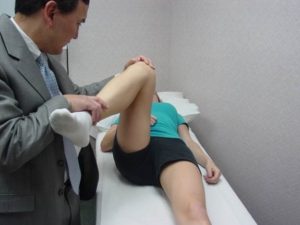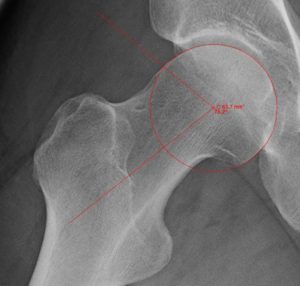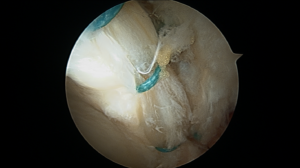Labral Tears and Hip Impingement Treated in Arlington, VA
 Hip impingement, or femoroacetabular impingement (FAI), is a condition where the ball of the hip joint (femoral head) bumps up against the walls of its socket (acetabulum). This condition develops in a patient’s tween or early teenage years. Many times, FAI itself is asymptomatic, since the potential lack of motion in an affected hip has always been there, and the patient does not recognize this as abnormal.
Hip impingement, or femoroacetabular impingement (FAI), is a condition where the ball of the hip joint (femoral head) bumps up against the walls of its socket (acetabulum). This condition develops in a patient’s tween or early teenage years. Many times, FAI itself is asymptomatic, since the potential lack of motion in an affected hip has always been there, and the patient does not recognize this as abnormal.
Over time, FAI can damage the rim of cartilage around the acetabulum (labrum), which normally forms a tight seal around the joint. Labral tears can disrupt this suction seal, allowing essential lubricating fluid to escape. The resulting friction in the hip joint can lead to pain and stiffness, and also hasten the development of arthritis.
Symptoms of Hip Impingement
The first sign of FAI is vague pain felt at the front of the hip or in the groin area, which is sometimes mistaken for a pulled muscle or hernia. Additionally, after a period of extended sitting, stiffness and tightness may develop. Patients may find that it is more comfortable to seat “slouched,” sometimes leaning to the unaffected side. Caused by inflammation and damage to the labrum, these symptoms may worsen and ultimately limit activities. If left untreated, contact between the ball and socket will continue to weaken the labrum, eventually causing it to tear.
Diagnosis
 A physician skilled in hip preservation can usually make a diagnosis based on talking to the patient, performing a detailed physical examination, and performing X-rays. The best test for assessment of hip FAI remains X-ray. A skilled clinician can easily diagnosis hip FAI with two to three X-rays. If there is impingement and if the patient does not respond to conservative treatment, an MRI may be ordered. MRIs can be used to directly assess labral tears, and also can pick up early signs of hip arthritis, before it becomes evident on X-ray.
A physician skilled in hip preservation can usually make a diagnosis based on talking to the patient, performing a detailed physical examination, and performing X-rays. The best test for assessment of hip FAI remains X-ray. A skilled clinician can easily diagnosis hip FAI with two to three X-rays. If there is impingement and if the patient does not respond to conservative treatment, an MRI may be ordered. MRIs can be used to directly assess labral tears, and also can pick up early signs of hip arthritis, before it becomes evident on X-ray.
Nonsurgical Treatment
Treatment for hip impingement usually begins conservatively. Nonsteroidal anti-inflammatory drugs (NSAIDs) can help reduce painful inflammation, and physical therapy can help stabilize the hip joint and the lumbar spine. This approach may be sufficient to limit abnormal contact between the femoral head and the acetabulum. Sometimes, an ultrasound-guided cortisone injection is used to decrease pain while the patient is doing physical therapy. However, if the symptoms persist or worsen, hip arthroscopy may be required to decrease the patient’s pain and improve function.
Surgical Treatment
 To relieve severe hip pain and prevent joint degeneration, a physician may suggest a surgical procedure to remove excess bone and provide clearance for the labrum. Once the excess bone has been removed, the labrum is reattached with anchors and surgical string to the rim of the socket to re-establish the joint seal. More importantly, at the same time, any FAI is addressed by reshaping the bone to eliminate the impingement. Following surgery, patients are typically weight bearing as tolerated (meaning they can put as much weight on their leg as feels comfortable), and they are in a hip brace for usually 4-6 weeks. Dr. Ochiai’s rehab starts IMMEDIATELY after surgery with passive range of motion exercises, and formal physical therapy is typically started within two weeks.
To relieve severe hip pain and prevent joint degeneration, a physician may suggest a surgical procedure to remove excess bone and provide clearance for the labrum. Once the excess bone has been removed, the labrum is reattached with anchors and surgical string to the rim of the socket to re-establish the joint seal. More importantly, at the same time, any FAI is addressed by reshaping the bone to eliminate the impingement. Following surgery, patients are typically weight bearing as tolerated (meaning they can put as much weight on their leg as feels comfortable), and they are in a hip brace for usually 4-6 weeks. Dr. Ochiai’s rehab starts IMMEDIATELY after surgery with passive range of motion exercises, and formal physical therapy is typically started within two weeks.
Nirschl Orthopaedic Center Can Help
 Arthroscopic hip surgery is a highly specialized area of hip preservation that requires a very specific skill set. At Nirschl Orthopaedic Center in Arlington, Virginia, Dr. Derek H. Ochiai is our board-certified, fellowship-trained orthopedic surgeon. He has extensive experience in hip arthroscopy, performing his first hip arthroscopy in 2003. Dr. Ochiai lectures and teaches hip arthroscopy courses internationally. He is a member of ISHA, the Hip Preservation Society, along with the Arthroscopy Association of North America.
Arthroscopic hip surgery is a highly specialized area of hip preservation that requires a very specific skill set. At Nirschl Orthopaedic Center in Arlington, Virginia, Dr. Derek H. Ochiai is our board-certified, fellowship-trained orthopedic surgeon. He has extensive experience in hip arthroscopy, performing his first hip arthroscopy in 2003. Dr. Ochiai lectures and teaches hip arthroscopy courses internationally. He is a member of ISHA, the Hip Preservation Society, along with the Arthroscopy Association of North America.
We understand that each patient has unique needs and deserves specialized treatment. Contact us at (703) 525-2200 to schedule an appointment with Dr. Ochiai at our office in Arlington, VA, where we will help you explore your treatment options for hip impingement and labral tears.
